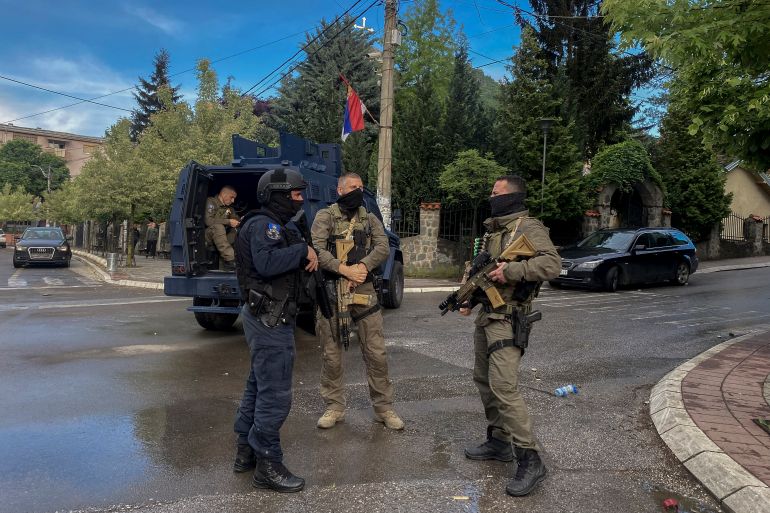Kosovo-Serbia tension: History, latest flare-up and what’s next?
Clashes erupt between police and local Serbs in northern Kosovo after new ethnic Albanian mayors take office.

Tensions between Serbia and Kosovo flared anew this weekend after Kosovo’s police raided Serb-dominated areas in the region’s north and seized local municipality buildings.
Violent clashes between Kosovo’s police and NATO-led peacekeepers on one side and local Serbs on the other have left several people injured on both sides.
Recommended Stories
list of 4 items- list 1 of 4NATO soldiers injured in Kosovo clashes with Serb protesters
- list 2 of 4NATO urges Kosovo to ease tensions with Serbia after clashes
- list 3 of 4Why is there another flare-up in tension in northern Kosovo?
- list 4 of 4Serbia blasts NATO forces over inaction during Kosovo clashes
The situation has again fueled fears of a renewal of the 1998-99 conflict in Kosovo that claimed more than 10,000 lives and left more than one million homeless.
Why are Serbia and Kosovo at odds?
Kosovo is a mainly ethnic Albanian-populated territory that was formerly a province of Serbia. It declared independence in 2008.
Serbia has refused to recognise Kosovo’s statehood and still considers it part of Serbia, even though it has no formal control there.
Kosovo’s independence has been recognised by about 100 countries, including the United States.
Russia, China and five European Union nations have sided with Serbia. The deadlock has kept tensions simmering and prevented full stabilisation of the Balkan region after the bloody wars in the 1990s.
What’s the latest flare-up about?
After Serbs boycotted last month’s local elections held in northern Kosovo, where Serbs represent a majority, newly elected ethnic Albanian mayors moved into their offices with the help of Kosovo’s riot police last Friday.
Serbs tried to prevent them from taking over the premises, but police fired tear gas to disperse them.
On Monday, Serbs staged a protest in front of the municipality buildings, triggering a tense standoff that resulted in fierce clashes between the Serbs and the Kosovo peacekeepers and local police.
How deep is the ethnic conflict in Kosovo?
The dispute over Kosovo is centuries old. Serbia cherishes the region as the heart of its statehood and religion.
Numerous medieval Serb Orthodox Christian monasteries are in Kosovo. Serb nationalists view a 1389 battle against Ottoman Turks there as a symbol of their national struggle.
Kosovo’s majority ethnic Albanians view Kosovo as their country and accuse Serbia of occupation and repression. Ethnic Albanian rebels launched a rebellion in 1998 to rid the country of Serbian rule.
Belgrade’s brutal response prompted a NATO intervention in 1999, which forced Serbia to pull out and cede control to international peacekeepers.
What is the situation locally?
There are constant tensions between the Kosovo government and the Serbs who live mainly in the north of the country and keep close ties with Belgrade.
Attempts by the central government to impose more control in the Serb-dominated north are usually met with resistance from Serbs.
Mitrovica, the main town in the north, has been effectively divided into an ethnic Albanian part and a Serb-held part, and the two sides rarely mix. There are also smaller Serb-populated enclaves in the south of Kosovo, while tens of thousands of Kosovo Serbs live in central Serbia, where they fled together with the withdrawing Serb troops in 1999.
Have there been attempts to resolve the dispute?
There have been constant international efforts to find common ground, but there has been no final agreement so far.
EU officials have mediated negotiations designed to normalise relations between the two. Numerous agreements have been reached during the negotiations, but were rarely implemented on the ground. Some areas have seen results, like introducing freedom of movement within the country.
An idea has been floated for border changes and land swaps as the way forward, but this was rejected by many EU countries out of fears that it could cause a chain reaction in other ethnically mixed areas in the Balkans and trigger more trouble in the region after the wars of the 1990s.
Who are the main players?
Both Kosovo and Serbia are led by nationalist leaders who haven’t shown readiness for a compromise.
In Kosovo, Albin Kurti, a former student protest leader and political prisoner in Serbia, leads the government and is the main negotiator in EU-mediated talks. He was also known as a fierce supporter of Kosovo’s unification with Albania and is against any compromise with Serbia.
Serbia is led by populist President Aleksandar Vucic, who was information minister during the war in Kosovo. The former ultranationalist insists that any solution must be a compromise in order to last and says the country won’t settle unless it gains something.
What happens next?
International officials are hoping to speed up negotiations and reach a solution in the coming months.
Any Serbian military intervention in Kosovo would mean a clash with NATO peacekeepers stationed there. Belgrade controls Kosovo’s Serbs, and Kosovo can’t become a member of the United Nations and a functional state without resolving the dispute with Serbia.